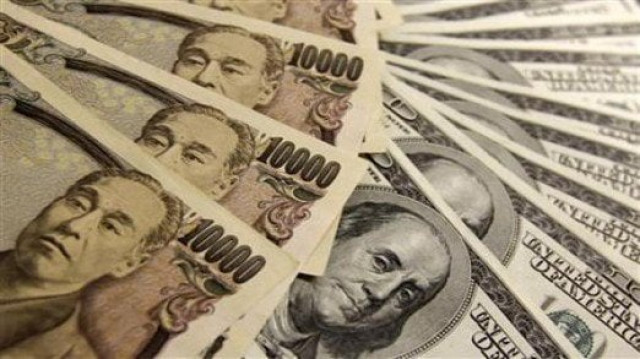Govt likely to introduce dollar-based saving scheme
Depositors will be protected from capital losses caused by any further devaluation of rupee

Increase comes mainly due to receipt of $500m from ADB. PHOTO: FILE
Depositors will be protected from capital losses caused by any further devaluation of the rupee that has already shed its value by more than 50 per cent in last one-and-a half-year.
In return, the proponents of the scheme – who is said to be the State Bank of Pakistan (SBP) governor – think that this will encourage people to save money in rupees that will lessen pressure on dollar buying.
The Central Directorate of National Savings (CDNS) will receive deposits in Pakistan rupee but will issue the US-dollar denominated certificates by converting the value of rupee on the prevailing day exchange rate, sources in the Ministry of Finance told The Express Tribune.
The profit on investment is proposed to be paid in rupee terms but again it will be worked out on the basis of US dollar value of that day. Not only that, on maturity of the scheme the depositors are proposed to be paid by calculating the value of the principal amount on that day's exchange rate.
‘Govt to provide standard healthcare facilities’
“The proposal has not been moved by the Ministry of Finance or CDNS, rather it is the brainchild of the SBP Governor Dr Reza Baqir,” a source in the Finance Ministry said.
The SBP governor is also chasing foreign hot money by keeping interest rates high, indication of which is given in the minutes of the second last Monetary Policy Committee (MPC).
A senior finance ministry official told The Express Tribune that the federal government would thoroughly study the dollar-denominated saving instruments proposal before its approval. He said no final decision has been taken yet.
If the proposal is endorsed by the federal cabinet, it is likely to promote dollarisation of the economy. People's trust on the local currency has already been shaken due to over 50% devaluation of local currency against US dollar since January 2018. In last fiscal year alone, rupee had shed its value by 34%.
The latest International Monetary Fund’s (IMF) assumptions depict a depreciation of Pakistan rupee by Rs63.4 to a dollar or 47% in four years (2019-2023).
The total loss in the value of the rupee in five years would be Rs78 or 64%, if the IMF assumptions are correct. These assumptions are subject to certain levels of inflows and outflows.
The sources said dollar-based saving instruments could further shake people confidence on the local currency and they will prefer to save in US dollars. Some businesses dealing with top-end clients have already started pegging cost of their services in the US dollar.
At present, only a overseas Pakistani can make investment in national savings schemes from abroad through cheque or draft in any currency. But the SBP governor wants this facility be extended to all people.
The Express Tribune contacted the SBP chief spokesman Abid Qamar to comment why the central bank governor was keen to launch this scheme. "The SBP, in its normal course of business, advises the MoF (Ministry of Finance) on various economic issues and make its suggestions.
“SBP will not confirm and comment on any issue which is under discussion till it is final and the stakeholders agree to share the details," said Qamar, while responding to a set of questions.
He had been requested to comment on the contents of the scheme, proposed by the governor and its intended benefits to the economy, if any.
The officials who are working on the scheme said the scheme was being planned on the assumption that those citizens who have kept their savings in the US dollar would convert the foreign currency into rupee and then invest the money into the new scheme.
In return, these people will get dollar-denominated certificates and profits on rupee-dollar parity bases. They said if the scheme remained successful it could also help to jack up low savings-to-GDP ratio that for last many years is hovering around 10%.
Pakistan's economy is already heavily dependent on the US dollar and an attempt had been made during the Pakistan Muslim League-Nawaz (PML-N) term to introduce the Chinese currency that has veined in past year.
Govt, PAD reveal agriculture programme worth Rs26bn
Chasing hot foreign money
The central bank has also taken aggressive monetary stance. The central bank has raised the key interest rates to 13.25%, which is 5.45% higher than core inflation rate.
Tight monetary stance seems aimed at attracting hot foreign money by making it lucrative for foreign investors to invest in the government securities. Its hints are available in the May 29 MPC meeting minutes.
"Another factor, which explains the relatively larger monetary tightening as suggested by the model, is uncovered interest rate parity viz-a-viz US economy," stated the minutes.
The federal reserve, in the latest March 2019 projections, has lowered its inflation projections, while showing little appetite for raising it in future.
This along with the depreciated PKR exchange rate path means that the SBP needs to hike the policy interest rate from an uncovered interest rate parity consideration. "This parity is important given the current management of reserves," the MPC minutes said.
Qamar ducked the question about setting high interest rates to attract foreign deposits.


















COMMENTS
Comments are moderated and generally will be posted if they are on-topic and not abusive.
For more information, please see our Comments FAQ